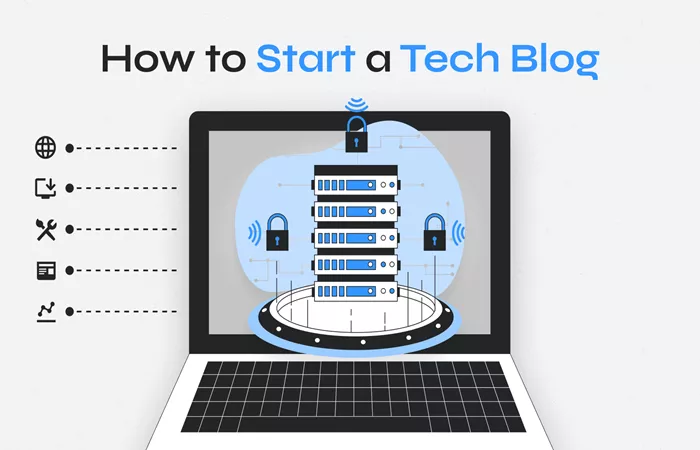Tech blogging is a great way to share knowledge, build a personal brand, and even earn money. If you love technology and want to start a blog, this guide will help. Follow these steps to create a successful tech blog.
Choose Your Niche
Tech is a broad field. Picking a niche helps you stand out. Ask yourself:
- What tech topics excite you the most?
- Is there a gap in the market?
- Can you write about this topic long-term?
Popular tech niches include:
- Software development
- Artificial intelligence
- Cybersecurity
- Gadget reviews
- Tech news and trends
A focused niche makes content planning easier.
Pick a Blogging Platform
Your platform affects your blog’s growth. Here are the best options:
WordPress (Self-Hosted)
WordPress.org gives full control. You need a domain and hosting. It’s flexible and SEO-friendly.
Medium
Medium is simple. You can write without technical setup. But you don’t own your content fully.
Blogger
Blogger is free and easy. However, customization is limited.
Ghost
Ghost is fast and clean. It’s good for writers who want simplicity.
For long-term growth, self-hosted WordPress is best.
Get a Domain and Hosting
A domain is your blog’s address (e.g., yourtechblog.com). Choose a short, memorable name. Avoid numbers and hyphens.
For hosting, reliable providers include:
- Bluehost
- SiteGround
- Hostinger
Look for good speed, uptime, and customer support.
Set Up Your Blog
After buying a domain and hosting, install WordPress. Most hosts offer one-click installation.
Next, pick a theme. Free themes like Astra or GeneratePress work well. For a premium look, consider themes from StudioPress or Divi.
Install essential plugins:
- Yoast SEO – Helps with search engine optimization.
- Akismet – Blocks spam comments.
- WP Super Cache – Speeds up your blog.
Customize your blog’s design. Keep it clean and easy to navigate.
Plan Your Content Strategy
Quality content attracts readers. Plan your posts in advance.
Research Topics
Use tools like Google Trends, AnswerThePublic, and Ubersuggest. Find what people are searching for.
Create an Editorial Calendar
An editorial calendar keeps you organized. Plan topics, keywords, and publishing dates.
Write High-Quality Posts
Your posts should be:
- Original – Offer unique insights.
- Well-Researched – Back claims with data.
- Engaging – Write in a conversational tone.
Aim for at least 1,000 words for in-depth articles.
Optimize for SEO
SEO helps your blog rank on Google. Follow these tips:
Use Keywords
Find keywords with tools like Google Keyword Planner. Include them in:
- Titles
- Headings
- First paragraph
- Image alt text
Write Strong Meta Descriptions
Meta descriptions appear in search results. Keep them under 160 characters. Include your keyword.
Use Internal and External Links
Link to other posts on your blog (internal links). Also, link to authoritative sites (external links).
Optimize Images
Compress images with tools like TinyPNG. Use descriptive file names (e.g., “best-laptops-2024.jpg”).
Promote Your Blog
Publishing posts isn’t enough. You need to promote them.
Social Media
Share posts on Twitter, LinkedIn, and Facebook. Join tech groups and forums.
Email Marketing
Build an email list. Offer a free ebook or checklist to get subscribers. Use Mailchimp or ConvertKit.
Guest Blogging
Write for other tech blogs. Include a link back to your site. This builds authority and traffic.
Engage with Readers
Reply to comments. Ask questions at the end of posts. Engagement keeps readers coming back.
Monetize Your Blog
Once you have traffic, you can earn money.
Affiliate Marketing
Promote tech products and earn commissions. Amazon Associates and ShareASale are good programs.
Ads
Use Google AdSense or Mediavine. Place ads where they don’t disrupt reading.
Sponsored Posts
Companies pay you to review their products. Disclose sponsorships to stay transparent.
Sell Digital Products
Create ebooks, courses, or templates. Sell them directly to your audience.
Track Your Progress
Use Google Analytics to monitor traffic. Check:
- Page views
- Bounce rate
- Top-performing posts
Adjust your strategy based on data.
Stay Consistent
Blogging takes time. Post regularly—at least once a week. Consistency builds trust with readers.
Keep Learning
Tech changes fast. Stay updated with industry news. Improve your writing and SEO skills.
Conclusion
Starting a tech blog might seem daunting at first, but remember – every successful blogger was once a beginner. The tech community thrives on shared knowledge, and your unique perspective could be exactly what someone needs.
As you begin this journey, focus on these three principles:
- Authenticity – Write about what genuinely interests you
- Consistency – Show up regularly for your readers
- Curiosity – Never stop learning and exploring new tech trends
The digital landscape needs more thoughtful tech voices. Your blog could be the next resource that helps someone solve a problem, learn a new skill, or make an important tech decision.
Don’t wait for perfection – launch your blog, publish your first post, and improve as you go. The most important step is simply to begin.
Welcome to the exciting world of tech blogging. Your journey starts now!
Relation topics:
- How To Start Technical Blogging?
- How to Start Technical Blogging?
- How to Make Money from Facebook Blogging

